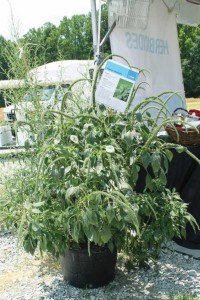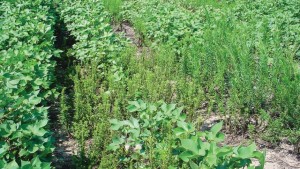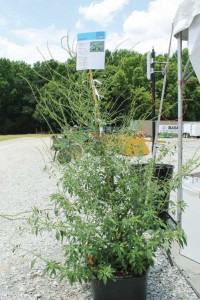Weeds To Watch 2015: Resistance Remains Riling
Although several trade shows/groups are commemorating various anniversaries during 2015, there is another agricultural-themed milestone this year that will not be celebrated. Fifteen years ago this spring, researchers in Delaware discovered the first example of the common weed marestail that showed resistance to glyphosate. In the intervening years, more and more weed varieties have also developed resistance to a host of herbicides. And they are growing in number like, you know, weeds.

Palmer amaranth
The overall numbers are staggering. Worldwide, crop losses to weed infestations cost growers more than $100 billion, according to weed researchers. In soybeans, for example, the presence of weeds four to eight inches tall can reduce yields by as much as six bushels per acre. According to research by the University of Illinois, particularly troublesome weeds such as waterhemp can cause up to a 40% yield loss in soybeans. When another known resistant weed, Palmer amaranth, is present, this figure can climb to as high as 79%.
During 2014, the number of farm acres affected by the resistant weeds menace continued to grow. According to a survey by Stratus, 57.6% of all U.S. growers reported the presence of glyphosate-resistant weeds in their crop fields, with the Southern portion of the country particularly hard hit with the problem. For instance, in Arkansas, 94.4% of growers said they were dealing with herbicide-resistant weeds during the year.
“During 2014, there were definitely more high-anxiety weeds spreading across much of the country,” says Luke Peters, U.S. corn herbicide product manager for Dow AgroSciences. “There has been an increase in the number of hard-to-kill marestail, and some plants in this family are starting to germinate at different times than they did in the past.”
John Kalthoff, cross-platform marketing leader for Dow AgroSciences, agrees. “In 2014, waterhemp resistant to most herbicides continued to rise in its prevalence across the number of acres on farms. Also, Palmer amaranth continued moving its geographic territory further north, making its way into southern Indiana and Illinois.”
The Troublesome Trio
Although there are several weed species that have exhibited known herbicide resistance, most agricultural market watchers still point to three varieties as the most difficult to control.

Marestail
• Marestail. This has been a historically troublesome to control annual broadleaf weed because of its rapid growth rate. Although generally considered a winter annual weed, marestail can germinate eight to nine months per year. And recently, evidence suggests marestail may be shifting to more spring and summer germination due to cropping systems and herbicide use patterns.
• Palmer amaranth. Now spreading into the Midwest, Palmer amaranth is both a rapid seed producer – generating up to one million seeds per plant – and a fast grower, averaging up to three inches per day. In some portions of the South, growers have reportedly resorted to manual weeding to keep Palmer amaranth from overrunning their fields.

Waterhemp
• Waterhemp. Known for its aggressive nature, this small-seeded annual broadleaf weed has developed resistance to several popular herbicide types, including triazines, ALS, PPO inhibitors, glyphosate and 2,4-D. According to experts, effective waterhemp control requires scouting throughout the growing season to catch the weed early and ensure timely herbicide applications.
Of course, according to Luke Bozeman, technical market manager, herbicides for BASF, timing has always been the most effective way to deal with troublesome weeds. “Timing is everything,” says Bozeman. “Once weeds have emerged, there is a limited window for applying a post-emergence herbicide before the weeds grow too large to control or crops are beyond the size that allows an herbicide application. It is imperative that these weeds are controlled before they go to seed so that their progeny aren’t around to affect yield in the next growing season.”
New Tools In The Offing
Besides timing, new products can also be employed to tackle herbicide-resistant weeds, say experts. With so many weeds now showing resistance to multiple herbicides, crop protection product manufacturers have responded with a host of new herbicides featuring multiple active ingredients. During 2014, some of examples of this approach to weed control included the introductions of SureStart II from Dow AgroSciences (featuring three active ingredients: Acetochlor, clopyralid and flumetsulam), Solstice from FMC Agricultural Solutions (which combines the active ingredients mesotrione and fluthiacet-methyl) and Fierce XLT from Valent U.S.A. Corp. (combining flumioxazin, pyroxasulfone and chloriumuron).
“Fierce XTL is a premium residual herbicide for higher weed pressure in the Midwest,” says Dr. John Pawlak, product development manager for Valent. “With three modes of action and up to eight weeks of control, Fierce XLT is an extremely important tool for soybean growers fighting tough, yield-robbing weeds such as Palmer amaranth and waterhemp.”
And this multiple active ingredient/modes of action trend has continued into 2015 as well. In January, DuPont Crop Protection received federal registration for its Revulin Q herbicide, with select state approvals expected in time for the 2015 growing season. According to Jeff Carpenter, portfolio manager, North America corn and soybean herbicides for DuPont, Revulin Q combines two active ingredients – nicrosulfuron and mesotrione – with a built-in safener, providing for more crop safety. “Revulin Q can provide excellent control of such hard-to-manage weeds such as lambsquarter, pigweed and ragweed by using two modes of action in the ALS and HPPD classes,” says Carpenter.
Another new herbicide that sports a crop safener is DiFlexx from Bayer CropScience. According to Al Luke, row crop marketing lead for the company, DiFlexx combines dicamba with a CSI Safener to provide reliable weed control in the corn market. “The product was just approved by the EPA in February,” says Luke. “During our 2013 field trials, DiFlexx was shown to control such tough weeds as Palmer amaranth, waterhemp, ragweed and lambsquarter. It also manages more than 100 annual and perennial weeds, including those resistant to glyphosate-, PPO- and ALS-based herbicides.”
Yet To Come Developments
Speaking of dicamba, many in the agricultural community are anxiously awaiting the approval of both dicamba- and 2,4-D-tolerant cropping systems to join those already in the glyphosate- and glufosinate-tolerant ones. Already, several crop protection product makers are lining up new herbicides to cater to these cropping systems such as Enlist Duo from Dow AgroSciences and Engenia from BASF.
According to Miriam Paris, Xtend System launch manager for Monsanto Co., the company’s new Roundup Ready 2 Xtend soybeans and Bollgard II XtendFlex cotton are very close to receiving their sign-offs from federal regulators. “This is a significant milestone in providing growers new tools to manage weeds and time more effectively, which will help them have better harvests,” says Paris. “With this, Monsanto is introducing XtendiMax with Vapor Grip technology, which combines both glyphosate and dicamba into another important tool growers can utilize to control weeds in their fields.”
Also in the final stages of federal registration at the time of this article was Acuron herbicide from Syngenta Crop Protection. A selective herbicide for burndown and residual weed control in corn, Acuron combines four different active ingredients (mesotrione, atrazine, S-metolachlor and bicyclopyrone) to utilize three different modes of action. According to Dr. Ryan Lins, research and development scientist, product evaluation, biological assessment, North America for Syngenta, Acuron has shown good control of numerous troublesome weeds. This includes not only lambsquarter, Palmer amaranth, waterhemp and marestail, but cocklebur, morning glory and kochia.
“Many growers are looking forward to the introduction of dicamba-tolerant crops into the market, but there are hints that a few of these weeds are already beginning to show some resistance to this chemistry,” says Lins. “In these cases and others, Acuron can be used along with other herbicides to provide better weed control.”






